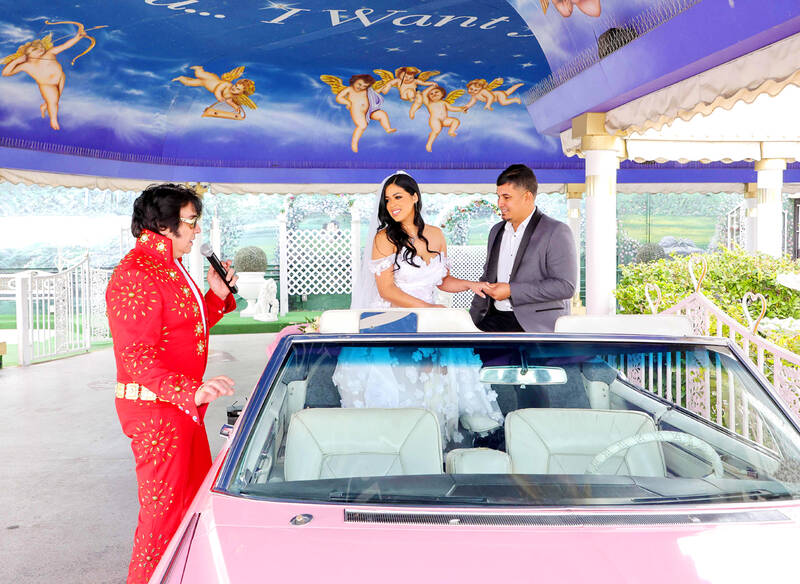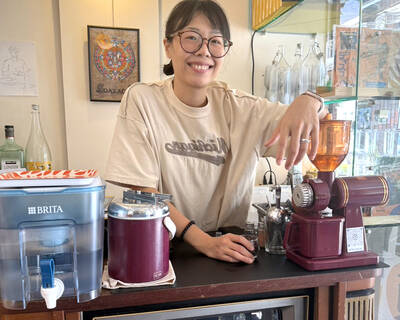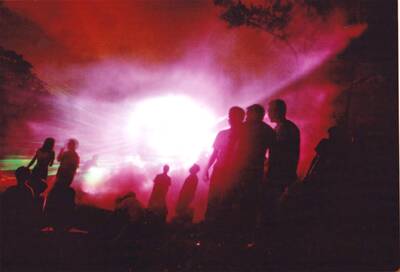A friend who proposed to his fiancee over the holidays told me the Instagram ads popped up not long after he shared a photo of her new, glittering diamond.
“Rings made with 100% real T rex fossilized bone,” screamed a post from Manly Bands, a line of wedding rings designed for men. “Step into the saga with our Lord of the Rings Collection,” read another, promoting not a line built with hobbit bones, but one officially licensed by the fantasy epic.
Perhaps the most cursed image: a Batman-inspired ring, with “Ha ha ha” inscribed on the inner side, a nod to the psychotic Joker, most recently played by Joaquin Phoenix.

Photo: AFP
“Instant annulment if he shows up to the wedding wearing this,” I texted the fiancee.
Manly Bands was founded by a Utah couple, John Ruggiero and Michelle Luchese, after their own search for a wedding ring left them wanting more — the industry, they found, gave men too few ring choices, and they thought even the most boring options cost too much money. Manly Bands offers bro-y designs plucked straight from a 2010s-era man cave, with rings made from whiskey barrels, asteroids and, yes, “legally and ethically sourced” dinosaur bones. (In the US, it’s illegal to dig for bones on public land without a government permit. Collectors can make deals with private landowners to skirt this law, but the definition of “ethically” varies greatly among them.)
Along with the Joker, other DC Comics figures, such as Superman, Batman and the Green Lantern, have received the Manly Bands treatment, immortalized in rings for better or worse, in sickness and in health. The cheapest Manly Band, a simple silicone ring, costs US$30 (since silicone rings are flexible, these are marketed to men who work with their hands). The prices rise all the way to US$4,295, for a black zirconium and diamond sideband option, set with a Jack Daniel’s barrel inlay. These options are supposed to fit a hole in the market for, well, “manly” looking bands.
It’s a good time to offer non-traditional looks: according to Brides, “men’s wedding bands are no longer ‘one style fits all.’” Shop for one, and you’ll find classic looks alongside art-deco designs, rose gold, Celtic knots and even baseball-inspired bands.
A brand called Modern Gents hawks wood, titanium and tungsten rings with names like the Bourbon, the Force Flex and the Stealth. Search “men’s wedding ring” on Etsy, and you’ll find similar bands, including a US$300 Tolkien-esque option made of Damascus meteorite and crushed gold leaf.
On TikTok, many of Manly Bands’ most enthusiastic supporters are, actually, women. “HAD to drip my husband out,” one creator wrote in a video that shows her fiance wearing a glossy black ring. “This is your sign to bling him out girlies.”
In another rave review, one woman unboxed her husband-to-be’s band.
“I ordered this,” she said, even though I’m pretty sure that’s his job.
What’s wrong with your father’s basic gold ring? Not enough gembones, I guess. Derek Guy, a fashion writer and commentator also known as “the menswear guy” on X, says that like my engaged friend and me, he doesn’t understand why some men’s jewelry has to rely so heavily on over-the-top masculine references.
“It often feels like companies are corralling men into their stores by saying it’s OK for men to wear this type of jewelry,” Guy said. “Not everything has to be gendered, and men can wear things outside of very cliche masculine stereotypes.”
CRINGEY VOWS
But even as some couples attempt to break down gender binaries in marriage and fashion, other grooms cling to those stereotypes. Some of the examples are egregious. Last month, a groom named Cody became TikTok’s villain of the day when a video of his short-but-anything-except-sweet vows went viral.
“I promise to smack that ass every chance I get,” he told his beloved. When the officiant tried to get him to say more, Cody declined.
In March, another groom’s vows, which could have doubled as a discarded Dane Cook bit, enraged viewers. Sample quote: “Only two things are required to keep me happy: keep my belly full and my balls empty. Though you’re amazing at half of it, we really need to get you some cooking lessons.”
Cringey vows live in the same universe as joke wedding cake toppers, some of which feature a woman dragging a man down the aisle, or standing disapprovingly over him as he plays video games. They revive tired, painfully heterosexual tropes that deem weddings as frivolous extravaganzas meant for women, events men trudge through as a chore.
“With these rings and those bad vows, it’s like men don’t want to express any romantic emotion, even on their wedding days,” said Emily Haswell, a TikToker who has posted about Manly Bands. “God forbid a man say something nice, out loud, about his partner, during their weddings.”
Traditional wedding rings will probably outlast the macho alternatives. The symbol has been around since Roman times, presented by the groom to the bride during an event known as the sponsalia. Back then, rings were usually made from simple, iron materials, but they got fancier as the centuries passed.
“It was about making a visual symbol of your union that verified your status,” said Emma McClendon, an assistant professor of fashion studies at St John’s University.
The modern-day wedding-industrial complex dawned in the late 1940s, when a Philadelphia copywriter named Frances Gerety, working with De Beers, suggested the slogan “a diamond is forever.” The line, which Gerety later said she didn’t really like, thrust diamond engagement rings upon middle-class Americans, who until then didn’t see the luxury as a must-have.
Today, wedding influencers and publications like the Knot and Brides dutifully catalogue engagement ring trends, but men’s bands have largely been overlooked. McClendon sees the “manly” variety as a response to the hyper-personalization of weddings in the past 15 years that’s coincided with the rise of social media. If brides can customize their wedding gown or bachelorette party, why wouldn’t grooms opt for Superman rings? (One potential answer: they are grown adults.)
“These rings are an assertion of individualism, of wanting to play and be special,” she said. “It could be a rebellion against the institution of marriage, or it could just be something fun, in the same way a woman does with her dress.”
Manly Bands has yet to fully enter the mainstream — and with that, my engaged girlfriend might release a sigh of relief. Guy, the menswear writer, isn’t so sure the rings will ever cross the threshold.
“I don’t think you can go wrong with the classics, such as a simple gold ring,” he said. “With luck and some work, a marriage should last a long time, and one of the things I worry about when it comes to these manly bands is that the designs will feel very dated in 20 years.”

Cheng Ching-hsiang (鄭青祥) turned a small triangle of concrete jammed between two old shops into a cool little bar called 9dimension. In front of the shop, a steampunk-like structure was welded by himself to serve as a booth where he prepares cocktails. “Yancheng used to be just old people,” he says, “but now young people are coming and creating the New Yancheng.” Around the corner, Yu Hsiu-jao (饒毓琇), opened Tiny Cafe. True to its name, it is the size of a cupboard and serves cold-brewed coffee. “Small shops are so special and have personality,” she says, “people come to Yancheng to find such treasures.” She

In July of 1995, a group of local DJs began posting an event flyer around Taipei. It was cheaply photocopied and nearly all in English, with a hand-drawn map on the back and, on the front, a big red hand print alongside one prominent line of text, “Finally… THE PARTY.” The map led to a remote floodplain in Taipei County (now New Taipei City) just across the Tamsui River from Taipei. The organizers got permission from no one. They just drove up in a blue Taiwanese pickup truck, set up a generator, two speakers, two turntables and a mixer. They

The low voter turnout for the referendum on Aug. 23 shows that many Taiwanese are apathetic about nuclear energy, but there are long-term energy stakes involved that the public needs to grasp Taiwan faces an energy trilemma: soaring AI-driven demand, pressure to cut carbon and reliance on fragile fuel imports. But the nuclear referendum on Aug. 23 showed how little this registered with voters, many of whom neither see the long game nor grasp the stakes. Volunteer referendum worker Vivian Chen (陳薇安) put it bluntly: “I’ve seen many people asking what they’re voting for when they arrive to vote. They cast their vote without even doing any research.” Imagine Taiwanese voters invited to a poker table. The bet looked simple — yes or no — yet most never showed. More than two-thirds of those

Former Chinese Nationalist Party (KMT) chairwoman Hung Hsiu-chu’s (洪秀柱) attendance at the Chinese Communist Party’s (CPP) “Chinese People’s War of Resistance Against Japanese Aggression and the World Anti-Fascist War” parade in Beijing is infuriating, embarrassing and insulting to nearly everyone in Taiwan, and Taiwan’s friends and allies. She is also ripping off bandages and pouring salt into old wounds. In the process she managed to tie both the KMT and the Democratic Progressive Party (DPP) into uncomfortable knots. The KMT continues to honor their heroic fighters, who defended China against the invading Japanese Empire, which inflicted unimaginable horrors on the